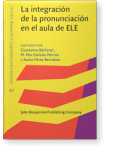Chapter 6
L2 pronunciation in the spotlight
From phonological awareness to oral production in communicative tasks
The present chapter puts forward several suggestions on how to incorporate the pronunciation
component into the Spanish as a foreign language (SFL) class, ranging from phonological awareness raising activities
to spontaneous speaking tasks. These proposals stem from the renewed interest in determining pronunciation instruction
effects in classroom settings. Specifically, recent second language (L2) speech acquisition research has shown that an
explicit focus on pronunciation in communicative tasks seems to lead to more accurate L2 segmental perception and
production. Moreover, as in the new descriptors of the CEFR Companion Volume, this chapter
prioritizes comprehensibility as the ultimate goal in the integration of pronunciation into communicative tasks.
Article outline
- 1.Introduction
- 2.Research insights into L2 pronunciation development
- 3.Integrating pronunciation into the communicative language class: Sample tasks
- 4.Future directions for incorporating the pronunciation component into L2 communicative language classes
- Author queries
-
References
-
Appendix
This content is being prepared for publication; it may be subject to changes.
